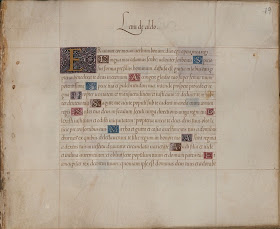













Plimpton MS 296 from the Rare Book and Manuscript Library at Columbia University (part of the Digital Scriptorium).
This Spanish parchment manual for calligraphers/copyists was made between 1500 and 1515. Unfortunately, that is all the information available. Twelve of the thirty one pages have been digitised (eleven are shown above).
While looking around fruitlessly for further information, I came across a site put together by the Department of Medieval Studies at Central European University in Budapest - Medieval Manuscript Manual (available in four languages). It's a basic overview of manuscript production (types, techniques, inks, typology etc) aimed at a non-professional audience and includes a useful glossary.
Gorgeous! I can't believe how thin the thin line on the e in the Domine is.
ReplyDeleteI can't cease to repeat to anyone I know this is one of the best blogs I've seen because of this kind of posts.
ReplyDeleteI love this lettering. It must have taken a long time to write something using this type of 'calligraphy'.
ReplyDeletehave you heard the term "horror vaccui"? mark stone used it to describe the manuscript decoration style of this period. i love that term. :)
ReplyDeleteThanks.
ReplyDeleteThanks gl, 'horror vacuii' is sooo much better than 'dislike of leaving empty space' (and I confess that I had to look it up, although I'm pretty sure I've seen it before).